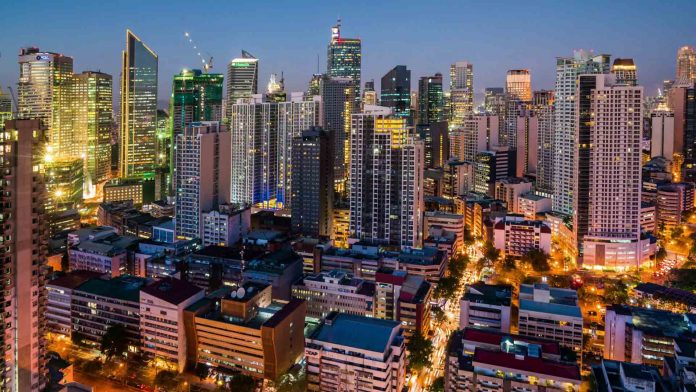PH ranks 22nd in emerging markets logistics index

Photo shows an aerial photo of the Makati Business District skyline in Metro Manila, illuminated at night. AP
MANILA – The Philippines still has some ways to go as it is currently number 22 in the Agility Emerging Markets Logistics Index 2020’s overall ranking, slightly above the halfway mark among the 50 most promising emerging logistics markets, down two points from 2019.
The Top 10 emerging logistics markets are China, India, UAE, Indonesia, Malaysia, Saudi Arabia, Qatar, Mexico, Thailand, and Turkey, in that order, according to the index prepared by logistics market research service Transport Intelligence and logistics company Agility.
“The strongest clusters of emerging markets are in the Arabian Gulf and Southeast Asia, thanks to business-friendly conditions and core strengths,” the recent report said.
Despite its trade and economic problems, China continues to lead the overall index, edging away from the other markets as improvements in core strengths across domestic and international logistics opportunities offset some declines in business fundamentals, the report said.
Notably, Vietnam is in 11th place, dropping from 10th as Thailand enters the Top 10 for the first time.
The index ranks 50 countries by three factors that make them attractive to logistics providers, shipping lines, air cargo carriers, and distributors. These sub-indexes are domestic logistics opportunities, international logistics opportunities and business fundamentals.
In terms of domestic logistics opportunities, the Philippines is currently at rank 19, down four places from a year ago. Leading the pack is still China, followed again by India, then Indonesia, UAE, and Brazil.
The top emerging markets in terms of international logistics opportunities are China, India, Mexico, Vietnam and Indonesia. The Philippines is in 13th place, up one spot.
Vietnam and Indonesia saw their international logistics opportunities scores improve, with gains made via a combination of volumes won as manufacturers switched production locations from China, as well as moderate increases in domestic demand.
Elsewhere in the top 10, two other Southeast Asian markets – Thailand and Malaysia – rose in the international logistics ranking as a result of infrastructure investment programs.
In Thailand, the Eastern Economic Corridor is developing sea and airport connectivity, as well as highway infrastructure to improve export efficiency and build volumes.
In Malaysia, infrastructure projects are helping to fuel a rapid rise in exports of electronic devices, which have risen as US tariffs depressed Chinese export volumes.
Under the business fundamentals sub-index, the Philippines is way down in 30th place, but an improvement of four places from 2019. The best places to do business in are UAE in top spot, then Malaysia, Saudi Arabia, Qatar and Bahrain.
The report also surveyed 780 logistics industry professionals for the report. Asked about the emerging markets with the highest potential as a future logistics market, India has been listed as having the greatest potential, edging out China. In third place is Vietnam, followed by Brazil and Indonesia. The Philippines has moved up by a significant five places to 16th spot year-on-year.
The Philippines’ upward movement as a promising future logistics market hinges on its infrastructure spending via the ‘Build, Build, Build’ program, healthy inflation levels and increased liquidity in the financial sector, the report said.
ASEAN neighbor Thailand also jumped to 7th, up from 13th last year, bolstered by the country’s improving business environment and regulatory frameworks, its Eastern Economic Corridor policy and manufacturing sector reforms.
Cambodia is a new entry in the list of emerging markets with the highest potential at no.18, up by a significant 13 places.
Meanwhile, the report also indicated which megacities are the most attractive as logistics hubs. The five winners are Shanghai, China (27 percent); Delhi, India (19 percent), Sao Paolo, Brazil (10 percent); Jakarta, Indonesia (9.4 percent); and Mexico City, and Mexico (8.3 percent). Manila is the seventh most attractive megacity for 6.1 percent of surveyed respondents.
According to the logistics industry professionals, the most important driver of logistics growth is good quality transport infrastructure (17.4 percent). This is followed by favorable government regulations (15 percent), access to global chains (11.8 percent), availability of skilled labor (10.7 percent), access to education/skills development in the domestic population (8.9 percent), availability of cheap labor (7.2 percent), and Internet access (6.1 percent).
“Connectivity is of course vital in the transportation of goods, and from that perspective, the high rating of infrastructure quality is unsurprising. In addition, as protectionism threatens to undermine the openness of trade, the efficiency of infrastructure is playing an increasingly important role in the business case of selecting certain trading partners in certain locations,” said the Agility report.
Tariffs and other protectionist changes in regulation governing international trade also threaten to add time and indirect costs of compliance, prompting survey respondents to place favorable government regulations alongside quality infrastructure at the top of the ranking.
Source: Panay News
